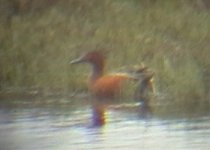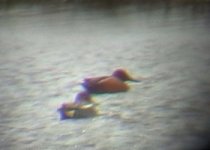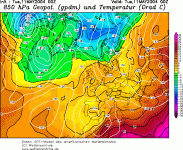Dear all,
News of a drake Cinnamon Teal on Loch Tuamister on the Western Isles, surely the most likely location for a genuine vagrant of this species (if ever there is going to be one in the UK), prompted me to book a day trip on Friday May 14th departing from Inverness Airport.
Initially I'd dismissed this occurence as just a curious record of a likely escape and recalled a fine drake Cinnamon Teal I'd seen with a group of Teal in Essex about five years ago. However, having deliberated the situation with a more open mind, the balance of probability of it being as good a candidate for a wild bird as there is likely to be was inescapable - recent sightings of American Coot, Redhead, American Wigeon and Green-Winged Teals, plus the Hooded Merganser of a few years ago, seemed ample evidence to me of the Western Isles to attract American vagrants. The trip was a 'go' situation!
Hurried phone calls to get a flight were made at 7pm Thursday evening followed by an overnight drive to Inverness. With news that the bird was still present I jetted off into the wide blue yonder only to touch down in the howling winds and driving rain in Stornoway.
The hire car was waiting for me (planning in advance is always worthwhile) and I drove across ten miles of peat bog being buffeted by the wind and navigating using the O.S. Map hastly borrowed from the library the night before (remember what I said about planning just now?).
Finally Loch Tuamister was located after having run the gauntlet of numerous indecipherable Gaelic road signs. I scanned the water of this shallow loch nestling in a valley and surrounded by fences. No sign! Disaster. No ducks - nothing.
Had a previous visitor tested the Teal's approachibility by stomping down to the water's edge I asked myself? I recalled the wildfowl hunting that had made the Hooded Merganser so unpredictable a few years ago. Was it 'open' season on wildfowl in May?
I looked again - a flash of orange was moving through the reeds by the shoreline. Surely it must be....yes, it was - the drake Cinnamon Teal. Taken aback by the extraordinary beauty of this piece of transatlantic avifauna (that is what a 'twitcher' should write isn't it?) I spent half an hour watching it ( on and off - I'm not that much of an anorak) and scanned the loch to see the vast array of Hebridean birds gathered at its shores - alright, it was one Lapwing.
I then went to see the prehistoric site at Callanish - archaeology is an interest of mine too by the way.
Returning to the airport and boarding the 4pm flight to Inverness I began to debate in my mind whether the undeniably favourable location, lack of clipped wings and lack of ring - albeit the last two were also shown by the Essex bird - would convince someone who enthusiastically labels rare wildfowl as 'plastic' to take a step back and to at least give the benefit of the doubt to this individual. Realising that I was too weary to continue this hypothetical debate I summed it up with 'you pay your money and you take your choice' - and since I'd done both I shut my eyes, thought no more about it and went to sleep.
I've attached a few photos of this bird which, like the Hooded Merganser before it, has effectively released those keen enough to see it from the need to travel throughout the UK collecting Cinnamon Teal 'insurance policies' in the hope of one coming up trumps. Mind you, if I'd seen the Essex individual in October, I needn't have seen this one at all - need I? I sense another debate coming on.....must dash.
Best wishes,
Lancey
News of a drake Cinnamon Teal on Loch Tuamister on the Western Isles, surely the most likely location for a genuine vagrant of this species (if ever there is going to be one in the UK), prompted me to book a day trip on Friday May 14th departing from Inverness Airport.
Initially I'd dismissed this occurence as just a curious record of a likely escape and recalled a fine drake Cinnamon Teal I'd seen with a group of Teal in Essex about five years ago. However, having deliberated the situation with a more open mind, the balance of probability of it being as good a candidate for a wild bird as there is likely to be was inescapable - recent sightings of American Coot, Redhead, American Wigeon and Green-Winged Teals, plus the Hooded Merganser of a few years ago, seemed ample evidence to me of the Western Isles to attract American vagrants. The trip was a 'go' situation!
Hurried phone calls to get a flight were made at 7pm Thursday evening followed by an overnight drive to Inverness. With news that the bird was still present I jetted off into the wide blue yonder only to touch down in the howling winds and driving rain in Stornoway.
The hire car was waiting for me (planning in advance is always worthwhile) and I drove across ten miles of peat bog being buffeted by the wind and navigating using the O.S. Map hastly borrowed from the library the night before (remember what I said about planning just now?).
Finally Loch Tuamister was located after having run the gauntlet of numerous indecipherable Gaelic road signs. I scanned the water of this shallow loch nestling in a valley and surrounded by fences. No sign! Disaster. No ducks - nothing.
Had a previous visitor tested the Teal's approachibility by stomping down to the water's edge I asked myself? I recalled the wildfowl hunting that had made the Hooded Merganser so unpredictable a few years ago. Was it 'open' season on wildfowl in May?
I looked again - a flash of orange was moving through the reeds by the shoreline. Surely it must be....yes, it was - the drake Cinnamon Teal. Taken aback by the extraordinary beauty of this piece of transatlantic avifauna (that is what a 'twitcher' should write isn't it?) I spent half an hour watching it ( on and off - I'm not that much of an anorak) and scanned the loch to see the vast array of Hebridean birds gathered at its shores - alright, it was one Lapwing.
I then went to see the prehistoric site at Callanish - archaeology is an interest of mine too by the way.
Returning to the airport and boarding the 4pm flight to Inverness I began to debate in my mind whether the undeniably favourable location, lack of clipped wings and lack of ring - albeit the last two were also shown by the Essex bird - would convince someone who enthusiastically labels rare wildfowl as 'plastic' to take a step back and to at least give the benefit of the doubt to this individual. Realising that I was too weary to continue this hypothetical debate I summed it up with 'you pay your money and you take your choice' - and since I'd done both I shut my eyes, thought no more about it and went to sleep.
I've attached a few photos of this bird which, like the Hooded Merganser before it, has effectively released those keen enough to see it from the need to travel throughout the UK collecting Cinnamon Teal 'insurance policies' in the hope of one coming up trumps. Mind you, if I'd seen the Essex individual in October, I needn't have seen this one at all - need I? I sense another debate coming on.....must dash.
Best wishes,
Lancey







